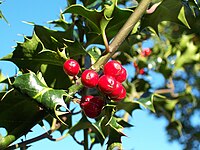
Photo from wikipedia
Ilex verticillata (L.) A. Gray (Winter Red) is a deciduous shrub and native to North America with high ornamental value, which was introduced into China in 2006. In Oct. 2020,… Click to show full abstract
Ilex verticillata (L.) A. Gray (Winter Red) is a deciduous shrub and native to North America with high ornamental value, which was introduced into China in 2006. In Oct. 2020, leaf spots occurred on I. verticillata at the nursery of Baima Base for Teaching and Scientific Research of Nanjing Forestry University (31°36'51"N, 119°11'8"E). In the early stage, there were small black spots occurred on the leaves. Then, these spots enlarged and coalesced into regular or irregular gray necrotic lesions with dark margins (Fig. S1A). The incidence of this disease was ca. 93%. Infected leaves were collected and surface-sterilized with 75% ethanol. Pieces cut from the margin of the lesions of ca. 5×5 mm were placed on potato dextrose agar (PDA) Petri plates and incubated at 25±2°C for 7 days. Ten Alternaria fungal isolates were single-spore isolated. Since these isolates shared similar morphological characters, isolates 9-1 and 15-2-2 were randomly chosen for further experiments. 2-yr-old potted I. verticillata were used for pathogenicity test in vivo. Leaves were surface-sterilized using 75% ethanol and wounded using a sterilized needle and inoculated with mycelial plugs or 10 μL of conidial suspensions (105 spores mL-1), respectively. The inoculated plants were kept in a growth chamber at 25°C and 85% RH under a 12-h photoperiod. PDA plugs without fungus or sterilized H2O were used as controls, respectively. The experiment was repeated 2 times. Each treatment had 3 replicates. By day 7, necrotic lesions were observed on the leaves inoculated with the fungal isolates 9-1 or 15-2-2. No lesions were found on the plants inoculated with PDA discs or dH2O (Fig. S1). To complete Koch's postulates, the pathogen was re-isolated from the infected leaves and shared similar morphological characteristics of colonies and conidia with the original inoculated isolates. Conidiophores of the 2 isolates were pale brown, erect or curved, (20.1-)21.4-29.9(-39.9) × (8.4-)10.6-14.9(-18.3) μm, (n = 30). Conidia were dictyospores, nearly ovoid or clubbed, brown or grayish brown, (25.2-)27.5-42.8(-47.9) × (5.7-)6-7.7(-8.7) μm, (n = 30), in branched or unbranched chains (Fig. S1). These morphological characteristics matched A. alternata (Woudenberg et al. 2013). The internal transcribed spacer (ITS), glyceraldehyde-3-phosphate dehydrogenase gene (GAPDH), endopolygalacturonase gene (endoPG), anonymous noncoding region (OPA10-2), small subunit gene (SSU), and large subunit gene (LSU) of isolates 9-1 and 15-2-2 were amplified using primer sets of Woudenberg et al. (2013). The SSU (OK428540, OK428541), LSU (OK428538, OK428539), ITS (OK316966, OK316967), GAPDH (OK428542, OK428543), endoPG (OK428544, OK428545), and OPA10-2 (OK428536, OK428537) of isolates 9-1 and 15-2-2 showed 99, 99, 99, 99, 100, and 100% similarity to the sequences of A. alternata ex-type CBS 916.96, respectively. Phylogenetic analyses using concatenated sequences of ITS, GAPDH, OPA10-2, LSU, SSU, and endOPG also showed that the isolates of 9-1 and 15-2-2 clustered with A. alternata ex-type and was supported with a 100% bootstrap value (Fig. S2). Based on the morphological and phylogenetic results, these fungal isolates were identified as A. alternata. A. alternata was reported as the pathogen of leaf spot and other diseases on more than 380 hosts (Farr & Rossman, 2022). To our knowledge, this was the first report of A. alternata causing leaf spot on I. verticillata in China. This report is important because the discovery is related to the management strategies of the new pathogen on I. verticillata. The monitoring and control of the disease needs to be emphasized in the future.
Journal Title: Plant disease
Year Published: 2023
Link to full text (if available)
Share on Social Media: Sign Up to like & get
recommendations!